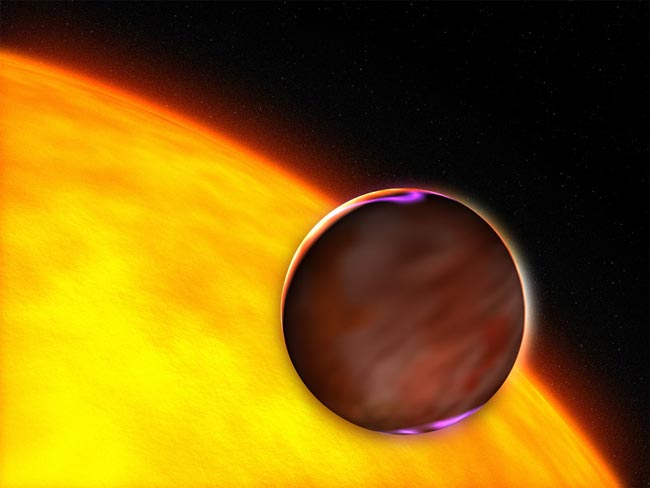Inside Exoplanets: Motley Crew of Worlds Share Common Thread

Scientists have discovered a correlation between the amount of heavy elements in giant Jupiter-like extrasolar planets known as "Pegasids" and their parent stars.
The finding, to be detailed in an upcoming issue of the journal Astronomy & Astrophysics, could help explain how giant gas exoplanets form and why they are so hard to detect.
So far, scientists have discovered more than 180 planets orbiting stars outside our solar system. As of April 2006, nine of these were "transiting planets," so named because they pass between their parent stars and observers on Earth once every orbit. Due to the limits of current telescopes, all of the transiting planets known thus far are very large gas planets that orbit very close to their stars.
Called Pegasids, or "hot Jupiters," these planets have masses between 110 and 430 times that of Earth and are large enough to cause a dip in starlight when they transit their stars. By measuring this dip, scientists can calculate a planet's mass and radius and then use these values to determine other properties of the planet such as density.
Before the current study, scientists didn't know what the common thread linking the nine hot Jupiters was. The planets seemed to be a motley crew: two were larger than models predicted; six appeared to be made up of mostly hydrogen and helium like our Jupiter; and the last had a large core but was much smaller than expected.
However, while comparing the mass of heavy elements, or "metallicity" of the Pegasids and the metallicity of their stars, researchers discovered a simple correlation: Pegasids born around stars that are as metal-rich as our Sun have large diameters--meaning they are large overall--but have small cores, while those orbiting stars with two to three times more metals than our Sun have small diameters but large cores.
"With this work, we are providing a coherent picture, showing that all the [Pegasids] can be explained within the same framework," said Tristan Guillot of the Observatoire de la Cote d'Azur in France.
Breaking space news, the latest updates on rocket launches, skywatching events and more!
"This is very important for [planetary] formation models because they have to explain this finding," Guillot told SPACE.com.
The finding also helps explain why so few Pegasids have been found using the transit technique: Because most have relatively large cores, they are smaller than expected and are thus more difficult to detect as they pass in front of their parent stars.
Last month, a team consisting of professional and amateur astronomers detected a tenth Pegasid that they dubbed XO-1b. Guillot said the new planet fits nicely with his team's metallicity correlation. Detected around a star 600 light-years away that is very similar to our Sun, XO-1b is large, about the size of Jupiter, but has a very small core.
- Stars May Be Eating 'Hot Jupiters'
- 10 Years of Planet Hunting: Amazing Variety Out There
- Way-Out World: New Technique Finds Most Distant Planet Ever
- Astronomers on Brink of Watershed in Planet Discoveries
Ker Than is a science writer and children's book author who joined Space.com as a Staff Writer from 2005 to 2007. Ker covered astronomy and human spaceflight while at Space.com, including space shuttle launches, and has authored three science books for kids about earthquakes, stars and black holes. Ker's work has also appeared in National Geographic, Nature News, New Scientist and Sky & Telescope, among others. He earned a bachelor's degree in biology from UC Irvine and a master's degree in science journalism from New York University. Ker is currently the Director of Science Communications at Stanford University.
